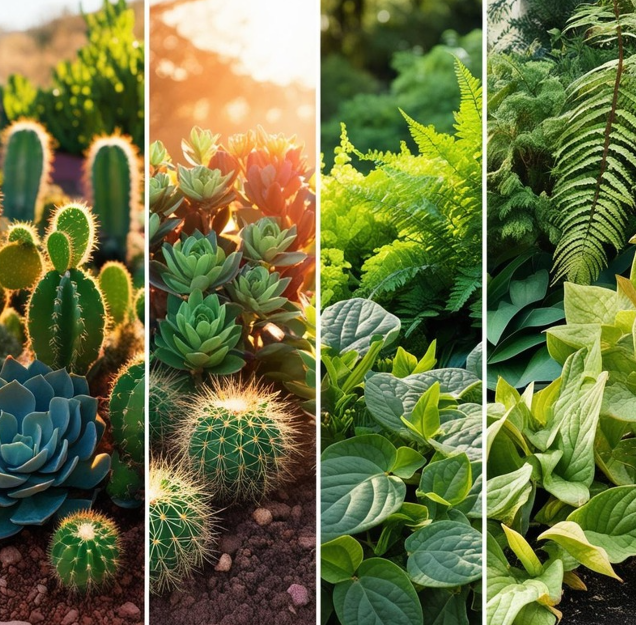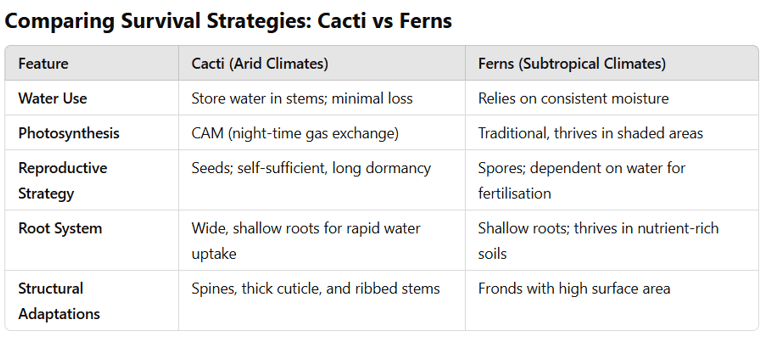From Deserts to Rainforests: How Plants Adapt and Thrive Across Climates


The world’s plants tell a story of survival, innovation, and resilience, shaped by millions of years of evolution. Nowhere is this more apparent than when comparing two extraordinary plant groups: cacti, the champions of arid deserts, and ferns, the ancient denizens of subtropical rainforests.
Both are masters of their environments, but their strategies for survival couldn’t be more different. Let’s dig into their evolutionary tales and explore what these plants teach us about the art of thriving in extreme conditions.
Cacti: Evolution’s Architects of the Arid
Cacti are the ultimate survivalists. Originating in the Americas, they evolved to conquer some of the harshest landscapes on Earth. Their adaptations are a masterclass in resourcefulness:
Succulent Tissues: Cacti store water in their stems, which swell after rare rains and sustain the plant through prolonged droughts.
Reduced or Absent Leaves: By eliminating traditional leaves and evolving spines, cacti minimise water loss and provide protection from herbivores.
CAM Photosynthesis: Unlike most plants, cacti open their stomata at night to reduce water loss during the heat of the day while still absorbing the carbon dioxide needed for growth.
Shallow but Extensive Roots: Their roots quickly absorb water from light rains before it evaporates.
The result? A plant perfectly tuned to thrive in arid climates, where survival hinges on capturing and conserving every drop of moisture.
Ferns: Ancient Pioneers of Lush Environments
While cacti have adapted to scarcity, ferns have thrived in abundance. Among the oldest plant groups on Earth, ferns date back over 350 million years and reached their peak during the Carboniferous period when the Earth was warm and humid. Their key features reflect their preference for moist, shaded environments:
Fronds for Photosynthesis: Fern fronds are delicate and highly divided, maximising surface area to capture light in dim, forested conditions.
Spores for Reproduction: Instead of seeds, ferns rely on spores, which are light, abundant, and easily dispersed by wind and water.
Water-Dependent Life Cycle: Ferns require water for reproduction, as their sperm must swim to fertilise eggs—a link to their ancient aquatic ancestry.
Shallow Roots and Rhizomes: Ferns often grow in nutrient-rich, moist soils or on other plants as epiphytes, making deep roots unnecessary.
These features have allowed ferns to flourish in subtropical rainforests, where steady rainfall and humidity support their life cycle.
Comparing Survival Strategies: Cacti vs Ferns


What Do These Plants Teach Us as Gardeners?
Cacti and ferns are living examples of how plants adapt to their environment. Their evolution offers valuable lessons for designing gardens that align with local climates:
In Arid Regions: Take inspiration from cacti by choosing drought-tolerant plants, using gravel mulches to conserve water, and designing landscapes that emphasise sculptural beauty.
In Subtropical Areas: Embrace lush, layered planting like ferns, focusing on moisture-loving plants that thrive in shade and humidity.
These plants also remind us of the joy of contrasts. Incorporating elements of both—such as a desert-inspired corner with succulents or a ferny nook by a water feature—can create a garden that tells a story of resilience and abundance.
Nature’s Masterpieces, Side by Side
Whether you’re drawn to the spiny silhouettes of cacti or the graceful fronds of ferns, these plants represent nature’s boundless creativity. They show us that there’s no single way to thrive—only endless possibilities for adaptation.
As gardeners, we have the privilege of celebrating these incredible stories by growing and appreciating plants from all corners of the Earth. Why not bring a little desert toughness and rainforest charm into your garden and watch the magic unfold?
